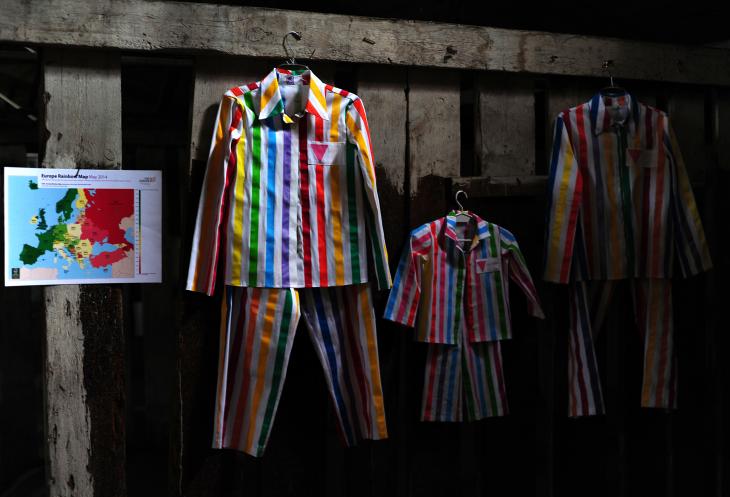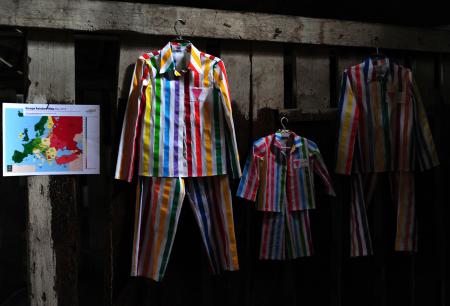


Izabela Maciejewska
Litzmannstadt
Artista
GHETTO XXI (Ghetto for Others)
Installazione, Tessile, 200x120x3cm
€ 10000
Aggiungi al carrello
Izabela Maciejewska, Ghetto XXI (Ghetto for Others), 2014
...Lekh would turn the bird over and paint its wings, head, and breast in rainbow hues until it became more dappled and vivid than a bouquet of wildflowers....leggi tutto
Izabela Maciejewska, Ghetto XXI (Ghetto for Others), 2014
...Lekh would turn the bird over and paint its wings, head, and breast in rainbow hues until it became more dappled and vivid than a bouquet of wildflowers. Then we would go into the thick of the forest....The bird would begin to twitter and attract a flock of the same species which would fly nervously over our heads. Our prisoner, hearing them, strained toward them, warbling more loudly, its little heart, locked in its freshly painted breast, beating violently. When a sufficient number of birds gathered above our heads, Lekh would give me a sign to release the prisoner. It would soar, happy and free, a spot of rainbow against the backdrop of clouds, and then plunge into the waiting brown flock. For an instant the birds were confounded. The painted bird circled from one end of the flock to the other, vainly trying to convince its kin that it was one of them. But, dazzled by its brilliant colors, they flew around it unconvinced. The painted bird would be forced farther and farther away as it zealously tried to enter the ranks of the flock. We saw soon afterwards how one bird after another would peel off in a fierce attack. Shortly the many-hued shape lost its place in the sky and dropped to the ground... When we finally found the painted bird it was usually dead...
Painted Bird, Jerzy Kosiński
The Ghetto of the 21st century installation touches upon the problem of being entangled in otherness which is not resultant from a conscious and deliberate decision. It is just like the otherness of the eponymous Painted Bird from a novel by Jerzy Kosiński which will inevitably be pecked to death by other birds of he same species because it differs from them. The artwork is a reflection upon the human nature in the context of modern civilisation. Has mankind having experienced the Holocaust drawn conclusions from this lesson of history and repudiated atavisms and prejudice? Can the people plucking up their courage to come out of the closet and embark on a journey to freedom expect any support from the society or are they doomed to ostracism?
Depriving people of the right to equal treatment and to living in accordance with their nature just because they belong to the so called „minority” still constitutes the norm in many countries.
"My grandmother was 16 when Dr. Mengele grabbed her chin and looked in her eyes. She was standing naked in the winter of 1943 on the selection queue just after arriving to Auschwitz. Mengele grabbed her chin looked into her eyes and asked her: "how old are you?". A strange thing about this story, is that i have a feeling it is one of my own. It is as if I was standing there in that cold winter day when the freezing gaze of Mengele is inquiring my face. I think this is something that could be said about any member of our family. We all know that this was a defining moment- not only in my grandmother's existence, but in our existence as well. Until today we marvel at that small miracle that allowed our birth: my grandmother having the nerve to lie, looking straight to the eyes of that man: "I am 18" she replied without a blink. Had she told him her real age, she would have been sent to the gas chamber together with her 5 younger siblings.
Truth and lie, survival and death, are sometimes not as 'black' and 'white' as we may conceive of them. The complexity of my grandmother's response and its ethical and psychological implications is something that I often think about when looking at my life. It reminds me to stay away from the immediacy of judgement and look into the depth and complexity of human emotion and interaction, and not to be caught in the first moral understanding of truth and false; right and wrong. The beauty of artworks is that they are too, complex and profound in their reading of the human condition. They should never be looked at for their face value alone.
When I encountered Izabela Maciejewska work as a judge at the Passion For Freedom Festival, it immediately grabbed my attention. My first interpretation of the work came from my personal journey and biography: as a granddaughter of a holocaust survivor I could not but think of those hanging pijamas, with the pink triangles stuck on them like name tags, as illustrators of the ordeal my people went through in the past century. The colours that were given to these stripped gowns, therefore, related, in my mind, to the history of my people.
The story that echoed in these colours was that of Joseph, the beloved son of Jacob, who had received from his father a beautiful coloured striped gown as a gift - a gown that eventually would lead to his abduction by Egyptian merchants and to a long life of serving the Pharaoes court. Anyone who knows the old testament's interpretation of that story, knows also that the presence of Joseph in the Egyptian court is what saved the Hebrews from the extinction in the heavy drought that dried the Middle East at that time from food resources. The same coloured gown, is also what would lead the Hebrews to their destiny as slaves and to their Exodus.
So it seems that the coloured stripped gown or pijama, has an intricate meaning as an object that symbolizes both privilege and slavery and the way that this symbol functions is that it marks its owner as different, as an outcast, as someone that deserves a different treatment or a different kind of attention.
Jacob had no harmful intentions when he gave Joseph the gown that will distinguish him from the rest of his brothers. He could not imagine that the jealousy of his brothers would be so strong, that they will bury Joseph in a hole and claim he had been hunted by beasts. Josheph's brothers, some would say, were only pulling a prank when they showed their father the coloured stripped gown covered in blood. They may not even imagined that Joseph would be taken by slave-merchants on their way to Egypt. But it is this distinction, this pre-supposed judgement marked by the symbol of the stripped coloured gown that propelled this history of slavery and liberation, and it is this distinction that this garment had performed, that had been the recurring theme of any violent discrimination.
Maciejewska's work is successful because it takes this charged symbol and re-uses it to demonstrate to us, as humans who are aspiring for tolerance, acceptance and freedom, how we make such distinctions, how we create prejudices - those tendencies that inevitably lead us to violence.
Sometimes, we ought to use such sensitive symbols, to point to social taboos in order to open our eyes to the inherent fear we have from the other. It matters how the other is defined : if its by their skin colour, religious affiliation, or sexual orientation - we have to learn to overcome the fear of that which is different, give up the prejudice and accept the other's existence as a human being that deserves the exact same right to exist as all of us. And we should be able to allow those people to live without them needing to lie about themselves, and feel forever guilty for their survival.
It is important that those who have the courage to remind us of our responsibility as individuals in a free society, would be able to use those common symbols that we all recognize as they are reflecting common and universal memories, in order to fight towards the freedom to express ourselves as humans.
Not only is it not offensive that Maciejewska chose the coloured stripped gown - but it is a privilege, as it allows us to re-read this tabooed symbol and apply it to other areas of our ethical efforts, so that it doesn't lose its force, it's meaning and it's complexity as a visual symbol. A symbol that reminds us that the problem does not start in the violent act in and of itself, but in the assumptions that we make about the other, and the separation of the other from the flock of humanity for one reason or another.
This is the reason I have voted Maciejewska as one of the best works in the show. Because its meaning crosses borders, cultures and histories. Its force rises from our ability to interpret it in a variety of ways- through a million historical and cultural lessons, and still be able to understand its core message. "
Lee Weinberg
Se acquisti questa opera e al ricevimento non sei soddisfatto, Celeste Network ti rimborserà il costo dell’opera. Hai 10 giorni dal momento in cui ricevi l’opera per cambiare idea ed organizzare la spedizione di ritorno.
Allegherò insieme all'opera un documento stampato che attesti la completa descrizione dell'opera, la validità autoriale e la provenienza.
5
5
Il Venditore ha scelto di utilizzare il serivizio di spedizioni DHL. Per conoscere entro 24 ore il costo di spedizione DHL clicca su 'Aggiungi al carrello', completa dettagli di 'Fattura e Consegna', e verrai contattato dal nostro staff con il preventivo.
News
celeste,





